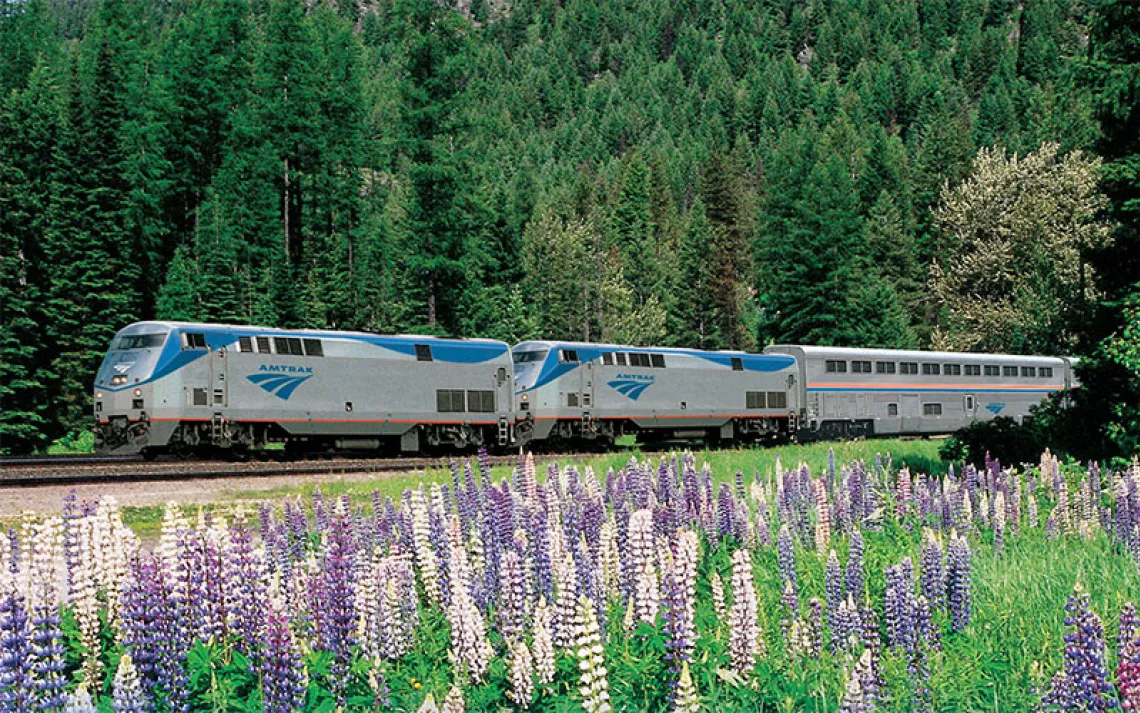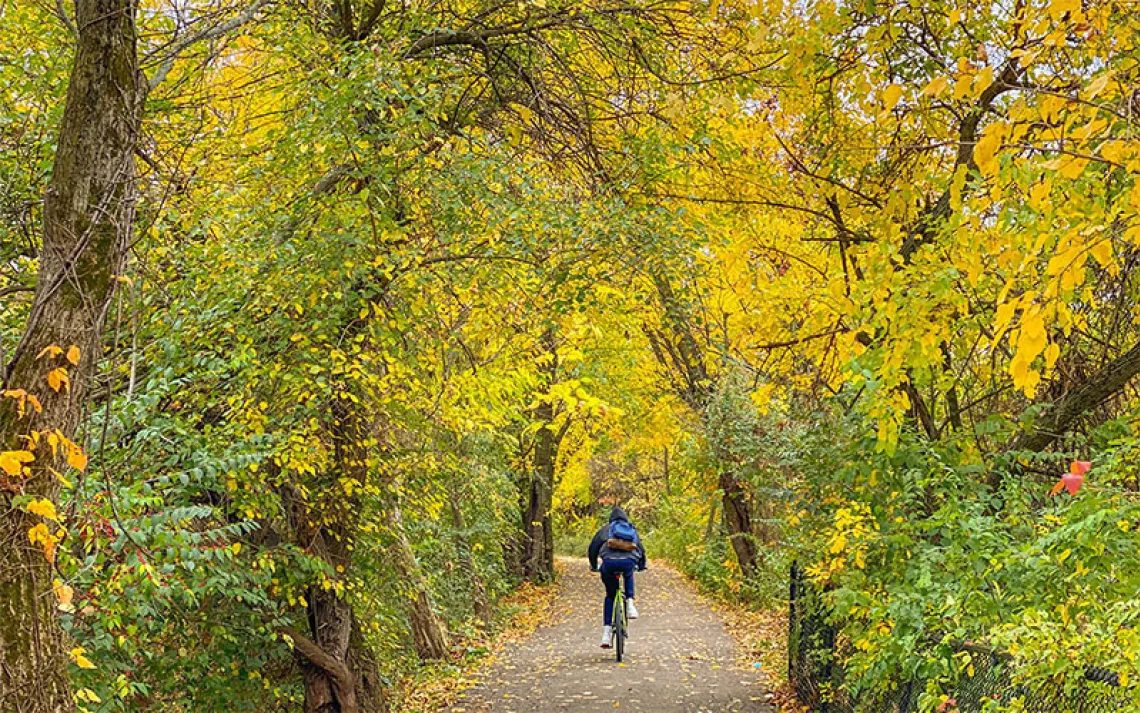The Last of the Southwest
Otero Mesa, the remnant of a forgotten grassland, looks for a little recognition

''The sky and land appear to be painted on a vast canvas in a way that forces the eye to focus afar.'' | Photo by Darren Huski
It is a strange and empty place, a place whose contours suggest that those who do not know it are best to leave it alone. . . . And, as with all strange and empty places in this increasingly crowded, increasingly monocultural world, Otero Mesa is an important island in our geography of hope.
—Otero Mesa: Preserving America's Wildest Grassland, Gregory McNamee
It was a place of legend and the legend was lost.
—Styve Homnick
ON A BRIGHT, CHILLY MORNING, I packed a bike into the back of a rental car and drove east from El Paso, steering toward the blank place on my map. I watched strip malls give way to salvage yards and then the sun-punished scrub and dust of rural West Texas. Before long, the prospect of relieving myself beside the road seemed like something of a public service.
But I kept going east and took a dirt road north before the Border Patrol station. Twelve miles later I was in New Mexico. The dust became dirt, and the scrub turned to sparse, brittle grass. Eventually, the ground found a subtle roll, like what a Lego man might encounter on a journey across a bedspread. The occasional yucca distinguished itself as the tallest thing in sight; nothing seemed to have a shadow. Welcome to Otero Mesa.

The author biking on Wind Mountain, a potential source of rare earth elements. | Photo by Peter Frick-Wright
Just north of the New Mexico-Texas border, Otero Mesa is the nation's largest contiguous piece of Chihuahuan desert grassland—considered the most endangered ecosystem in the United States. Conservationists have spent the last decade trying to save it, first from oil and gas developers, then from mining companies. Now, the Sierra Club and other conservation groups are lobbying President Barack Obama to designate it as a national monument, thus giving permanent protection to 1.2 million acres of fragile desert.
A few hundred years ago, Otero Mesa was a central gathering place and hunting ground for nomadic Apache tribes. It gradually became a refuge where tribes wouldn't be surprised by Spanish or American soldiers. It's land where you can see what's coming.
So maybe it was fitting that my only charter on this trip was to spend a week mountain biking Otero Mesa's dirt roads, taking in the territory with a fresh pair of eyes.
Along with the bike, I'd brought a tent, 15 gallons of water, a week's worth of food, and a massive head cold. On a sandy patch of ground on the mesa's eastern side, I set up a base camp from where I could embark on daylong rides.
Camp anywhere, I'd been told by Kevin Bixby, executive director of the Southwest Environmental Center. Unless it's obviously private land. If you open a gate, shut it behind you, he'd said. And don't worry about publicizing any locals-only spots. "At this point," Bixby said, "there's no danger of overloving Otero Mesa."
On my first day of riding, the view from my handlebars was undulating pasturelands. Faraway hills had the mien of rumpled felt; rain clouds bruised one corner of an otherwise pristine sky. Twice I scared up a ferruginous hawk, and twice it flapped hard to match my speed, keeping in formation at my 10 o'clock, sunlight glowing through its wings. Later on, a rabbit took an overland escape route in the shape of a lightning bolt. During one of my rest breaks, a badger heading downwind wobbled within 10 yards of me.

A homemade sign points to an Otero Mesa ranch. | Photo by Peter Frick-Wright
I noted all this with rote detachment, however, much like encountering a celebrated artwork and feeling nothing special. Except instead of museum legs, I had an industrial-grade cold that kept me hacking and wheezing my way across the mesa's chunky gravel roads and sucking down water in tremendous gulps. I pedaled through the grassland with my head down, trying to summon some memory of what proper breathing was like, even as two pronghorn—the world's second fastest land mammal—trotted distant arcs across my path.
Otero Mesa's wildlife is utterly dependent on healthy grasslands. Prairie dogs, for example, feed on the dominant grass species and make their homes among the grasses' roots. Their presence makes the soil more fertile and conducive to growing the types of broadleaf forbs that pronghorn like to eat. They also tailor the environment for burrowing owls and kit foxes, which build nests in abandoned prairie dog dens. And almost every carnivore on the mesa snacks on prairie dogs from time to time—they are something like corn dogs for cougars.
The grasslands survive here in large part because of a layer of calcium carbonate rock, sometimes called calcrete for its similarity to concrete. Forming a solid barrier two feet underground, calcrete keeps shrubs and invasive plants from establishing a deep root system, while allowing the shallower black grama grass roots to thrive.
If in a time of drought, however, the calcrete is uneven, cracked, or too deep—as it is today throughout much of the Southwest—the grass loses its edge and other, thirstier plants take hold.
The next day of riding was largely vanquished by headwinds, while day three took me to the center of the Cornudas Mountains, volcanic formations on the mesa's southern edge that jut from the landscape like Egyptian pyramids.
TO THE APACHE TRIBES WHO ONCE ROAMED this land, these mountains were sacred—a place for artwork and ceremonies. "It's one of the densest concentrations of rock art I've ever seen," said Deni Seymour, who has studied Apache archaeology for more than 25 years. "I'm really barely scratching the surface."

Otero Mesa's petroglyphs | Photo by Darren Huski
During pioneer days, the mountains served as a pragmatic navigational aid for drivers on the Butterfield Overland stagecoach route. Now, modern times are devolving them further, so that it's no longer the mountains that are valued but rather the rare earth elements inside them.
Rare earth elements aren't actually all that rare—just hard to find in concentrations that can be mined profitably. And while they have many unique utilities, one of the big ones is in the manufacture of powerful, lightweight magnets, as found in computer hard drives. They're also useful in flat-screen monitors, jet engines, lasers, and other things in which the U.S. military takes an interest. Right now, about 95 percent of the world's supply comes from China.
Midway through 2010, however, in an effort to feed a growing appetite for gadgets at home, China slashed exports of these metals. Prices climbed. The Pentagon freaked. Rare earth elements became an issue of national security.
Just as I set out past the towering cairn of 7,280-foot-high Wind Mountain, a truck pulled up, and out came Bobby Jones, a rancher whose family has been raising cattle on Otero Mesa since his great-grandfather came through these parts in the late 1870s, just about the time when white settlers could first make a life on the mesa without fearing Apache reprisal.

Left: Mescalero Apache elder Ted Rodriguez has lobbied New Mexico's congressional delegation to protect Otero Mesa and its petroglyphs. Right: Brooklyn-born Styve Homnick lives next to the Mescalero Apache reservation and works to protect Otero Mesa. | Ryan Heffernan (2)
Jones, who is 60 years old and resembles the Marlboro Man, has had 10 years' experience fighting oil and gas drilling. But now, he said, he felt caught between two 800-pound gorillas. In April 2011, a year after China kinked the hose on rare earth exports, Colorado congressman Mike Coffman introduced a bill designed to increase domestic mining of rare earth elements. That same month, the Colorado-based Geovic Mining Corporation announced that it had finished staking out five square miles of mining claims near the Cornudas Mountains.
Jones and I talked for more than an hour on a hilltop near his ranch. He doesn't want mining in Otero Mesa, but he also doesn't want it to become a national monument. Despite assurances to the contrary, he's afraid that if the mesa becomes a monument, he'll lose 85,000 acres of grazing privileges.
He's also renting land to Geovic for equipment storage, he said, so these may be bought-and-paid-for opinions, but I got the sense that Jones is a man who believes to his core that government should be as small as possible. "Mitt Romney is too liberal for me," he said at one point.
Other local ranchers echoed Jones's concerns, and while they're not the most outspoken bunch—they mostly want to be left alone—they helped persuade the Otero County Commission to pass an ordinance in May 2010 that opposes the designation of Otero Mesa as a national monument. On the other side of that fight is the Coalition for Otero Mesa, which has drawn together a diverse array of locals, elected officials, and national environmental organizations to lobby "for permanent protection of this rare and beautiful grassland."
I spent the rest of the afternoon meandering through the mountains, boosting up and down gravel inclines in the still air. My only rest was a stop at a mining claim beside the road: two wooden stakes in the ground marked with orange tape. It's unclear exactly what type of mine Geovic plans to build in Otero Mesa, but a similar project in Texas took the form of a vast, open pit.
ONE OF THE BEST HOPES for building lasting support for Otero Mesa is located on the western slope of Alamo Mountain, just a few miles from where HEYCO Energy Group first struck gas 15 years ago. The next day, I started my final ride there, streaking past windmills spinning slowly and cattle lowing good morning.
Alamo Mountain first caught wilderness advocate Styve Homnick's eye as he perused a coffee-table book sent to him by the New Mexico Wilderness Alliance. Though he'd worked on the Mescalero Apache reservation in his 20s and maintained friendships within the tribe, he'd never heard of its petroglyphs or ceremonial grounds. He asked a few friends in the tribe. They hadn't heard of them either.
"To not know these things, it was embarrassing," Mescalero elder Ted Rodriguez said.
Tribal history is a precious commodity for Apache tribes, which have been losing their language and culture since the U.S. government's policy of dislocation and assimilation created a gap in their oral tradition.
Homnick, Rodriguez, and several other tribal elders drove out to Otero Mesa in 2010 and found themselves in awe. Golden eagles swooped by, and pronghorn matched pace with their truck. Rodriguez had an overwhelming sense that his ancestors were speaking to him. "It got to the point that I didn't feel like it was an accident that we were out here," he said. "It captivated me."
Looping around the mountain's edge, I followed roads connecting stock ponds and paused occasionally to work up the nerve to play chicken with stubborn cattle. The route's terminus left me on the west side of the mountain, near the gated entrance to the petroglyph site. Walking up toward the peak, I began to understand why some Apache tribal members refer to Alamo Mountain as "a church."
The petroglyphs materialized on scattered slabs of volcanic rock as I closed the distance. A body with two heads and four arms hugged the rock with spread-eagle abandon; wind gods held court on their rocky perch; a rattlesnake dropped from the sky. There were abstract patterns, winged spirits, horned figures, and a handprint impressed like an artist's signature.
I found the unmistakable humped back of a buffalo, which used to roam the mesa, and myriad faces, symbols, and designs. Some looked to have been drawn with careful practice, others with a child's whimsy. All represented a collective history the loss of which I could not fathom.
I had spent five lonely days in Otero Mesa feeling sick, sluggish, and pessimistic about its chance of survival. Then I spent two hours looking at the petroglyphs and grew hopeful.
Since the Mescalero elders were made aware of the petroglyphs, they've had good news. In June 2011, a group of Apache, including Rodriguez, traveled to Washington, D.C., to lobby for national monument designation. While they do not represent the tribe in an official, political sense, they found lawmakers receptive and plan to go back. In November, with help from Homnick, two local newspapers began publishing weekly sections on Otero Mesa. Ranchers report a noticeable increase in visiting hikers.
Back at Alamo Mountain, I found a spot to rest on the dark rocks overlooking the mesa, with radiating heat soothing my spastic lungs. My view was the same crispy grass I'd seen on arrival, but after a week in the mesa, it no longer looked empty. I knew where to find pronghorn loping into the distance and how to surprise wandering badgers. I knew where the grasslands were succumbing to the sand and where they were thriving, with dormant wildflowers poised for a leap to knee height come November rain.
But this panorama offered something else. There was a car parked in a well-worn, dusty semicircle near the road, and I could see strands of footprints from weekend visitors beginning to cohere into a trail. A map of Alamo Mountain struggled in the wind against the side of a bush; a shiny sliver of granola bar wrapper winked in the sunlight. It wasn't hard to picture crowds shuffling past the petroglyphs and then lunching in a wind-sheltered alcove, before returning home ready to make a fuss the next time someone proposed drilling or mining here.
I gathered the litter on my way down the hill, taking its presence as an odd sign of hope.
 The Magazine of The Sierra Club
The Magazine of The Sierra Club



